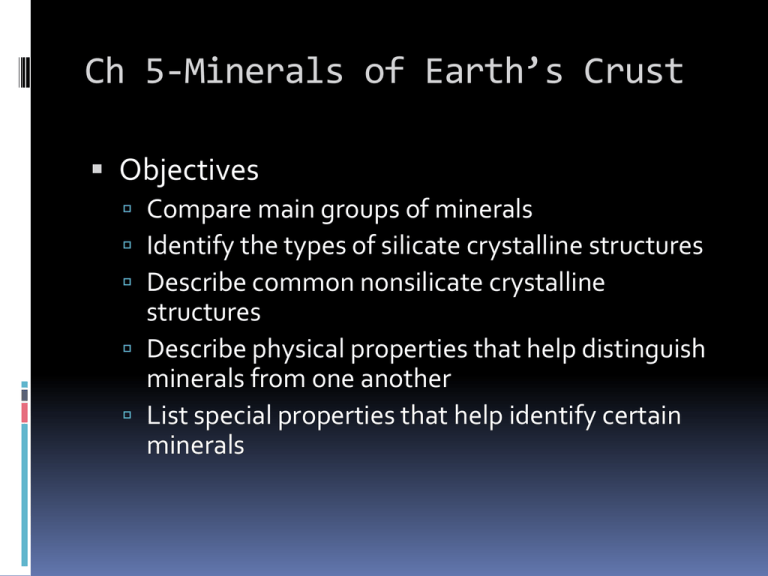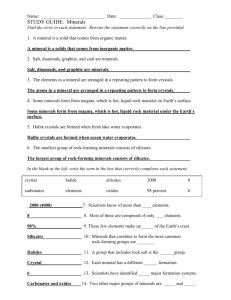Ch 5-Minerals of Earth's Crust
advertisement

Ch 5-Minerals of Earth’s Crust Objectives Compare main groups of minerals Identify the types of silicate crystalline structures Describe common nonsilicate crystalline structures Describe physical properties that help distinguish minerals from one another List special properties that help identify certain minerals Characteristics of Minerals Define mineral Natural, usually inorganic solid, has special chemical composition, orderly internal structure, characteristic set of physical properties Main groups of Minerals 4,000 kinds of minerals Fewer than 20 are common Forming minerals=common minerals that form the rocks that make up Earth’s crust 10 minerals that make up 90% of Earth’s crustQuartz, orthoclase, plagioclase, muscovite, biotite, calcite, dolomite, halite, gypsum, ferromagnesian 2 groups-silicate and nonsilicate minerals Based on chemical composition Silicate Minerals Mineral that contains combination of silicon and oxygen Feldspars are most common Make up 96% of Earth’s crust Feldspar and quartz make up 50% Nonsilicate Minerals Minerals that do not contain compounds of silicon and oxygen 4% of Earth’s crust Carbonates, halides, native elements, oxides, sulfates, sulfides Silicate Crystalline Structures Minerals in Earth’s crust all have crystalline structure Crystal-solid whose atoms, ions, or molecules are arranged in regular repeating pattern Types of crystalline structures Isolated tetrahedral silicates Ring silicates Single chain silicates Double chain silicates Sheet silicates Framework silicates Nonsilicate Crystalline Structures Variety of crystalline structures Cubes, hexagonal, prisms, irregular masses Similar to silicates but center is not silicon If mineral has same ion at center of tetrahedral, commonly share similar crystal structures Sec 2-Identifying minerals Physical properties of minerals Color Streak-color of powder Luster-light reflected from mineral’s surface Cleavage-ability to split Fracture-ability to fracture Hardness-ability to resist scratching Mohs Hardness Scale Crystal shape Density-ratio of mass to volume Mineralogists-Earth scientists that examine, analyze, and classify minerals. Use the physical properties Other properties of minerals Fluorescence & phosphorescence Ability to glow under ultraviolet light, and after light is turned off Chatoyancy and Asterism Reflected light minerals display silky appearance. Six sided shape appears when mineral reflects light Double refraction Crystals bend light, produce double image of any object viewed through them Magnetism Minerals that contain iron Ex. Magnetite Radioactivity Arrangement of protons and neutrons in nuclei of some atoms is unstable Ex. Uranium and radium







